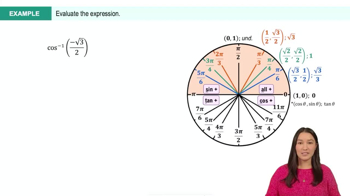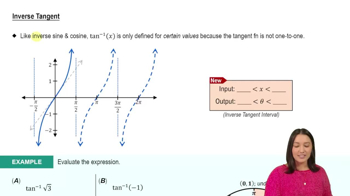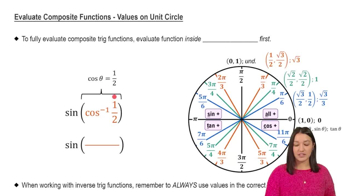Table of contents
- 0. Functions7h 52m
- Introduction to Functions16m
- Piecewise Functions10m
- Properties of Functions9m
- Common Functions1h 8m
- Transformations5m
- Combining Functions27m
- Exponent rules32m
- Exponential Functions28m
- Logarithmic Functions24m
- Properties of Logarithms34m
- Exponential & Logarithmic Equations35m
- Introduction to Trigonometric Functions38m
- Graphs of Trigonometric Functions44m
- Trigonometric Identities47m
- Inverse Trigonometric Functions48m
- 1. Limits and Continuity2h 2m
- 2. Intro to Derivatives1h 33m
- 3. Techniques of Differentiation3h 18m
- 4. Applications of Derivatives2h 38m
- 5. Graphical Applications of Derivatives6h 2m
- 6. Derivatives of Inverse, Exponential, & Logarithmic Functions2h 37m
- 7. Antiderivatives & Indefinite Integrals1h 26m
- 8. Definite Integrals3h 25m
0. Functions
Inverse Trigonometric Functions
Problem 3.10.80a
Textbook Question
Tracking a dive A biologist standing at the bottom of an 80-foot vertical cliff watches a peregrine falcon dive from the top of the cliff at a 45° angle from the horizontal (see figure). <IMAGE>
a. Express the angle of elevation θ from the biologist to the falcon as a function of the height h of the bird above the ground. (Hint: The vertical distance between the top of the cliff and the falcon is 80−h.)
 Verified step by step guidance
Verified step by step guidance1
Identify the relationship between the height of the falcon (h) and the vertical distance from the top of the cliff to the falcon, which is given by the expression 80 - h.
Recognize that the angle of elevation θ can be expressed using the tangent function, where tan(θ) = opposite/adjacent. In this case, the opposite side is the vertical distance (80 - h) and the adjacent side is the horizontal distance from the biologist to the point directly below the falcon.
Since the falcon is diving at a 45° angle, the horizontal distance from the biologist to the falcon will be equal to the vertical distance (80 - h) due to the properties of a 45° right triangle.
Set up the equation for the tangent of the angle of elevation: tan(θ) = (80 - h) / (80 - h). Since both sides are equal, this simplifies to tan(θ) = 1.
Use the inverse tangent function to express θ in terms of h: θ = arctan(1), which indicates that θ is a constant angle of 45° regardless of the height h of the falcon.
Recommended similar problem, with video answer:
 Verified Solution
Verified SolutionThis video solution was recommended by our tutors as helpful for the problem above
Video duration:
2mPlay a video:
Was this helpful?
Related Videos
Related Practice













